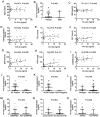Serum levels of 14-3-3η are associated with increased disease risk, activity and duration of rheumatoid arthritis in Chinese patients
- PMID: 32742321
- PMCID: PMC7388387
- DOI: 10.3892/etm.2020.8761
Serum levels of 14-3-3η are associated with increased disease risk, activity and duration of rheumatoid arthritis in Chinese patients
Abstract
The aim of the present study was to determine the association between serum 14-3-3η expression levels and disease risk, inflammation level and disease duration in Chinese patients with rheumatoid arthritis (RA). A total of 45 Chinese patients with RA, 45 patients with osteoarthritis (OA) and 44 age- and sex-matched (with the RA group) healthy control (HC) subjects were consecutively recruited for the present case-controlled study. In addition, the demographic and clinicopathological characteristics of the patients with RA were collected. Serum samples were obtained from patients with RA, patients with OA and the HCs, and the serum levels of 14-3-3η were determined by ELISA. Compared with that in the OA patients (P=0.006) and HCs (P<0.001), 14-3-3η expression was significantly increased in RA patients, and receiver operating characteristics (ROC) analysis indicated that it served as a potential predictive marker for the risk of RA. In patients with RA, serum levels of 14-3-3η were positively correlated with disease duration (P=0.003), erythrocyte sedimentation rate (P=0.006) and disease activity score in 28 joints (P=0.025). The proportion of rheumatoid factor (RF)-positive patients (P=0.023) and anti-citrullinated protein antibody (ACPA)-positive patients (P=0.002) with RA was increased (when 14-3-3η expression was increased) compared with RF-negative patients or ACPA-negative patients, respectively. Of note, 14-3-3η serum levels were able to distinguish patients with established RA (disease duration, >2 years) from patients with early RA (disease duration, ≤2 years) with an AUC of 0.759 (95% CI, 0.612-0.905), and the sensitivity and the specificity at the best cut-off point (14-3-3η=0.613 ng/ml) were 79.3 and 75.0%, respectively. Furthermore, 14-3-3η was able to differentiate between RF-positive RA patients and RF-negative patients or HCs. In conclusion, circulating 14-3-3η expression may serve as a novel biomarker for disease risk and activity of RA in Chinese patients.
Keywords: 14-3-3η; Chinese; disease activity; disease duration; disease risk; rheumatoid arthritis.
Copyright: © Tu et al.
Figures





References
LinkOut - more resources
Full Text Sources
